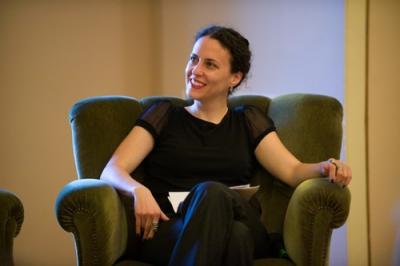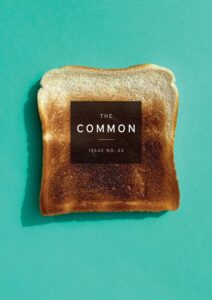The Best American Poetry 2013, ed. Denise Duhamel, included Peter Jay Shippy’s “Western Civilization” as well as Angela Veronica Wong and Amy Lawless’ “It Can Feel Amazing to Be Targeted By a Narcissist,” both from The Common Issue 03.
Hyphen-Nation
I write to you from what splits my first name. The overpass between two nationalities. The sandbar between the shore and the winking sea. Marie and Helene walk down the street, holding hands. The hyphen contains both of the things it connects, but also a third thing that is neither Marie nor Helene.
Al-Fadjr (2013)
Al-Fadjr, an Algerian daily, covers The Common‘s growing international presence and work with Arab literature.
Ammoun (2013)
Ammoun, the top news website in Jordan, features The Common‘s collaboration with Hisham Bustani.
Fiona Maazel on Cults, Comedic Fiction, and Country Music
S. TREMAINE NELSON interviews FIONA MAAZEL

Fiona Maazel is the author of the novels Last Last Chance and Woke Up Lonely, the latter of which was recently published by Graywolf Press. She is the winner of the Bard Prize for Fiction and a National Book Foundation “5 Under 35” Honoree. She teaches at Brooklyn College, Columbia University, New York University, Princeton University, and was the Picador Guest Professor at the University of Leipzig, Germany. Nelson first met Maazel, briefly, during a book launch party at Powerhouse Arena in Brooklyn, New York. They traded a few emails and agreed to conduct their interview online, over Gchat.
Changing Places: Mining Mongolia
I hadn’t come to Mongolia seeking an education in the politics of development, but the signs of rapid, double-edged growth were everywhere. In Bayan-Olgii, the westernmost city, a huge entourage of Western foreigners driving foreign vehicles tore into the yurt camp where I stayed one night. They shook the felt walls of the camp with their shouting and drinking and ramen noodle-making, and the next morning did burn outs in the gravel driveway and honked as they left, showering pebbles over the camp owners’ barelegged children.
Around the town of Bayan-Ollgi sat multitudes of great, hulking tourist vehicles, resting at roadsides like over-fed weight lifters. They were protected by new, fat tires, for the sand, and strapped to their roofs and sides were shiny water and petrol cans, spare tires, tool kits, maps and jacks – all the accouterments of a military reconnaissance mission. I had the strong impression of being in an invaded country, watching a civilian-clothed army loot stores for bread and toilet paper.
The Four Times of Day by William Hogarth
William Hogarth (1697–1764), the eighteenth-century English artist known for his satirical views of contemporary life, first published The Four Times of Day engravings in 1738, based on paintings completed two years earlier. Although some of Hogarth’s other series profess a moral, the intent of these works was to portray humorous caricatures of contemporary figures. The images are rich in detail, providing a glimpse into the world of 1730s London.
Ammoun (2013)
Ammoun, the top news website in Jordan, features The Common‘s collaboration with Hisham Bustani.
Tahawolat (2013)
Tahawolat, a Lebanese culture and politics website, highlights Issue 06’s publication of stories from Hisham Bustani.
Riffle (2013)
Riffle covers The Common’s second annual celebration of place in NYC on “Riffle World Literature”.



